With this series of weekly updates, WOLA seeks to cover the most important developments at the U.S.-Mexico border. See past weekly updates here.
CBP released data covering migration at the U.S.-Mexico border in May, which was an important transitional month because the Title 42 pandemic expulsions policy came to an end on May 11. The agency encountered 61 percent fewer migrants after May 11 than it did during the month’s first 11 days. CBP expanded appointments for asylum seekers using the “CBP One” app, but other asylum seekers subject to the Biden administration’s new “transit ban” rule faced high barriers to protection.
The House of Representatives Appropriations Committee passed, on a party-line vote, its 2024 budget bill for the Department of Homeland Security. It reflects the priorities of the House’s Republican majority and directly confronts Biden administration priorities at the border. The bill, which stands little chance of passage in anything resembling its current form, would restart border wall building, hire 1,800 Border Patrol agents, expand migrant detention, and slash funding for processing, humanitarian assistance, alternatives to detention, and detention oversight.
The family of 8-year-old Anadith Danay Reyes Alvarez laid her to rest at a June 16 funeral service in New York. “We want justice for her so that no one else has to go through this,” read a statement. Reyes died of influenza on May 17, after nine days in Border Patrol custody in Harlingen, Texas, where Border Patrol personnel and medical contractors failed to heed the family’s pleas for urgent aid.
On June 20 U.S. Customs and Border Protection (CBP) released data about its encounters with migrants at the U.S.-Mexico border in May 2023. This was an important transitional month, because the Title 42 pandemic expulsions policy came to an end on May 11.
The monthly numbers show a mixed picture, as they combine the period before May 11, when CBP’s daily migrant encounters at times exceeded 10,000, with the period after Title 42’s end, when migration dropped sharply amid uncertainty over how the Biden administration would apply a new rule restricting access to asylum.
In border areas between ports of entry, CBP’s Border Patrol component reported 169,244 “encounters” with migrants during May. That was 8 percent fewer than in April, and 25 percent fewer than in May 2022. A majority of those “encounters” (98,850) happened during the first 11 days of May. Border Patrol’s daily average dropped from 8,986 on May 1-11 to 3,520 on May 12-31. That is a reduction of 61 percent.

Regular posts to the Twitter account of outgoing Border Patrol Chief Raúl Ortiz indicate that encounter numbers remain lower in June, with daily averages staying flat, ranging between about 3,000 and 3,300.
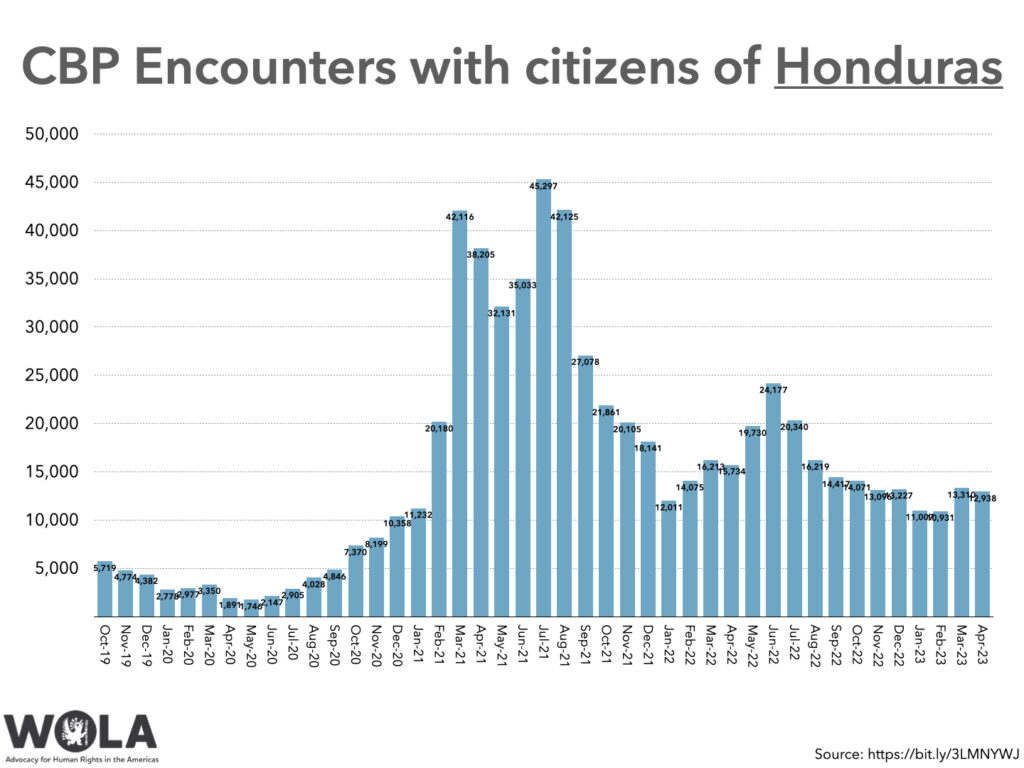
In addition to Border Patrol’s encounters between ports of entry (official border crossings), CBP’s Office of Field Operations encountered 35,317 more migrants at the ports. This is a new single-month record, exceeding the number of migrants at ports of entry in April 2022, when CBP processed a large number of Ukrainians following the Russian invasion.
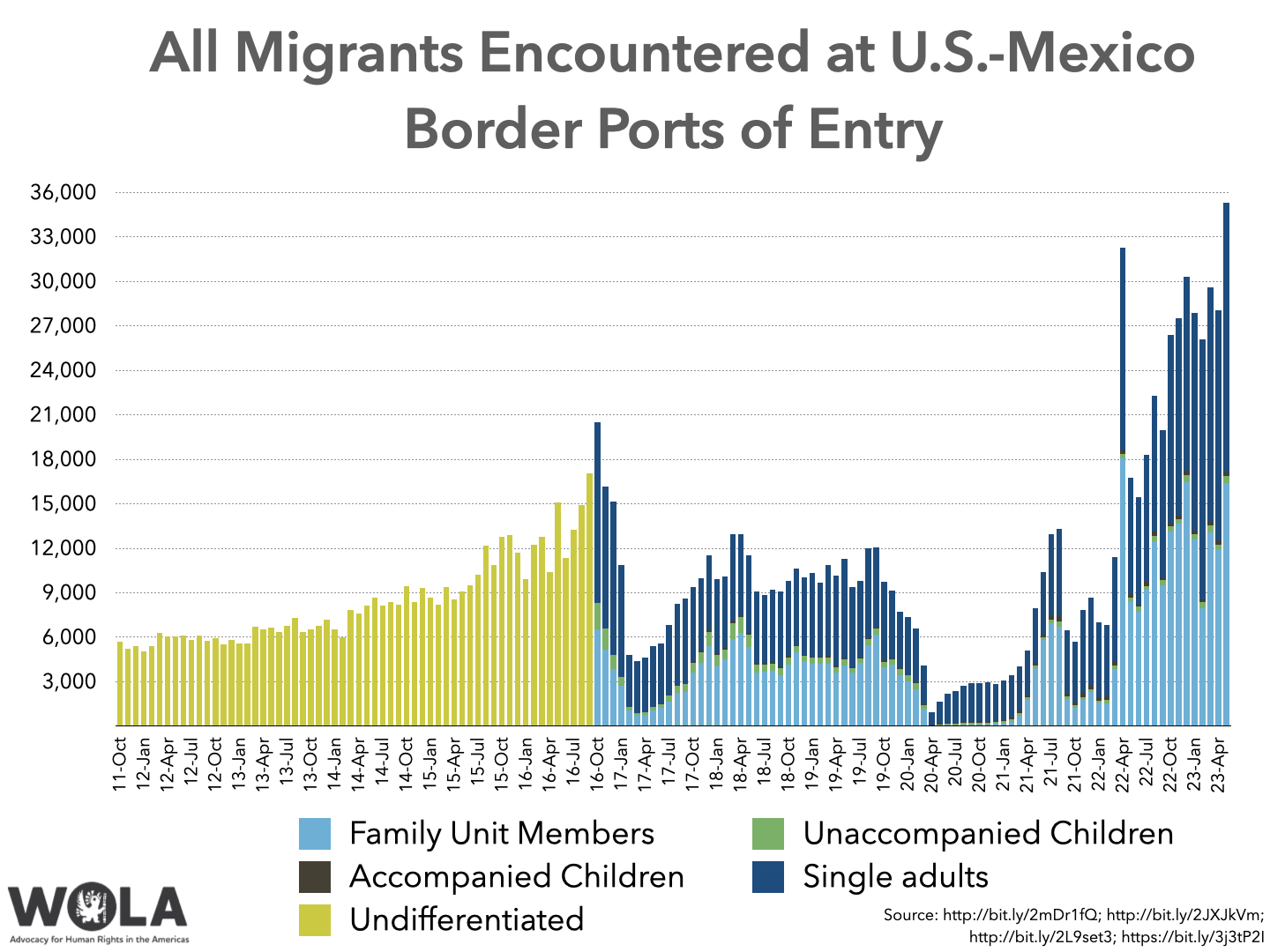
Of that 35,317, 4 out of 5 (28,696) were asylum seekers who had succeeded in making appointments to apply at ports of entry, using a feature on CBP’s smartphone app, “CBP One.” In mid-January, the app became—with very few exceptions—the only way to secure an asylum appointment at a port of entry. Between then and May 31, CBP reports that more than 106,000 people have used the app to make appointments.

After May 11, CBP increased the number of daily CBP One appointments it would accept. The daily average had been about 740-760 between December and April, but increased to 1,273 during the last 20 days of May. As of June 1, CBP is accepting 1,250 per day.
The coordinator of El Paso’s Office of Emergency Management, Lt. Jorge Rodriguez, told the city’s council that his office is now seeing “the bulk of our numbers” of recently released asylum seekers coming from El Paso’s ports of entry: more users of the phone application and fewer migrants who crossed between the ports and ended up in Border Patrol custody.
The MIT Technology Review published an in-depth analysis of the CBP One app on June 16. Despite improvements to its functionality, reporter Lorena Rios found that the app still poses a barrier to many people. “The need for a working smartphone with enough battery charge and a good internet connection is ‘an expense they are having to make as a family, prioritizing that over food on any given day,’” Brian Strassburger, a Jesuit priest who works with migrants in the Mexican border state of Tamaulipas, told Rios.
Adding the Border Patrol and port-of-entry numbers makes a total of 204,561 migrant encounters at the U.S.-Mexico border during May 2023, 3 percent fewer than in April and 15 percent fewer than in May 2022. Excluding people who were apprehended more than once, CBP encountered a total of 136,673 “unique individuals” in May, 2 percent fewer than in April.
The declining migration numbers owe largely to the Biden administration’s new “Circumvention of Lawful Pathways” rule, implemented on May 11. In most cases, this rule disqualifies from asylum people who cross both without a CBP One appointment, and (if they are not Mexican) without having tried and failed to get asylum in a third country en route. (Those who make CBP One appointments are not required to have sought asylum elsewhere.)
In a court filing reported by the Los Angeles Times, the Biden administration noted a sharp drop in successful asylum screenings at the border.
The numbers show that, thus far [between May 12 and June 13], 8,195 asylum-seekers who crossed the border have had the new rules applied to them and 88 percent had the policy limit their chance at asylum. These migrants were forced to pass a higher standard of screening reserved for different forms of protection under U.S. law. Some 46 percent of migrants who were forced to go through the new approach either cleared the higher standard or established an exception to the rule, like a medical emergency.
That 46 percent is down from 83 percent of single-adult asylum seekers who passed initial screenings (credible fear interviews) between 2014 and 2019.
The National Immigrant Justice Center (NIJC) issued a new update about what its attorneys have experienced while conducting legal consultations with 23 people subjected to the new procedures. NIJC has had to carry out these consultations entirely by telephone, as CBP denies attorneys physical access to its border-area detention facilities. There, migrants wait in austere conditions that, according to CBP’s own standards, are not meant to hold them for more than 72 hours under non-emergency circumstances.
“Forcing people through a complex and emotionally taxing asylum screening process in this environment inevitably results in systemic barriers to legal access and rapid deportations that send people directly back to persecution, torture, or death,” NIJC found. Among barriers are “limiting access to phones for legal consultations; failing to notify attorneys of their clients’ scheduled screenings and immigration court reviews; denying asylum seekers in CBP custody access to pen and paper; and requiring that people physically sign a notice of entry of appearance to secure the attorney/client relationship, while often failing to facilitate the required signature.”
In the court filing cited by the Los Angeles Times, the Department of Homeland Security’s (DHS) assistant secretary for border and immigration policy, Blas Nuñez-Neto, revealed that according to the Department’s intelligence, an estimated 104,000 migrants are currently in northern Mexico, within eight hours’ drive of the U.S. border. They “appear to be ‘waiting to see whether the strengthened consequences associated with the rule’s implementation are real,’” Nuñez-Neto wrote.
CBP’s May data showed little change in the nationalities of migrants encountered at the border. Mexico and Venezuela remained the number one and two countries of origin, as in April, though migration from Honduras rose sharply from April, for unclear reasons, placing Honduras in third ahead of Colombia.
The number of migrants from Colombia encountered in May (18,128) was the second-most ever, exceeded only in May 2022. Citizens of Colombia may travel to Mexico visa-free, though Mexico has placed new restrictions on travel it regards as suspicious and Mexican security forces have been recorded soliciting bribes from Colombians for allowing them to leave the airport and proceed. According to Witness at the Border’s monitoring, U.S. authorities removed Colombian migrants back to their country on 93 flights during the first 5 months of 2023.
The following four charts illustrate migration trends by nationality since March.
1- The nationalities of migrants whom Border Patrol encountered between ports of entry:
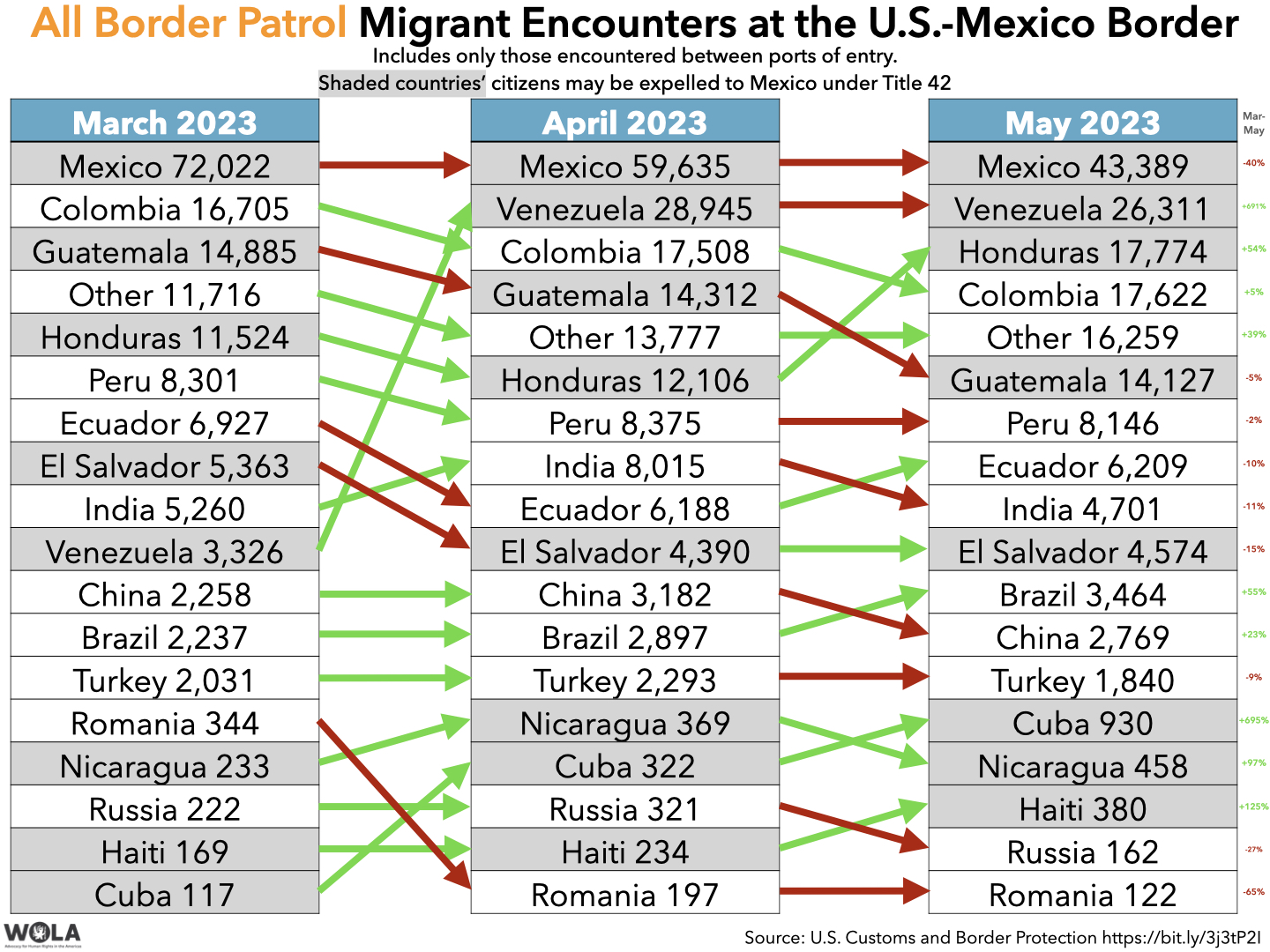
2- The nationalities of migrants encountered at the ports of entry, 81 percent of them with “CBP One” appointments:
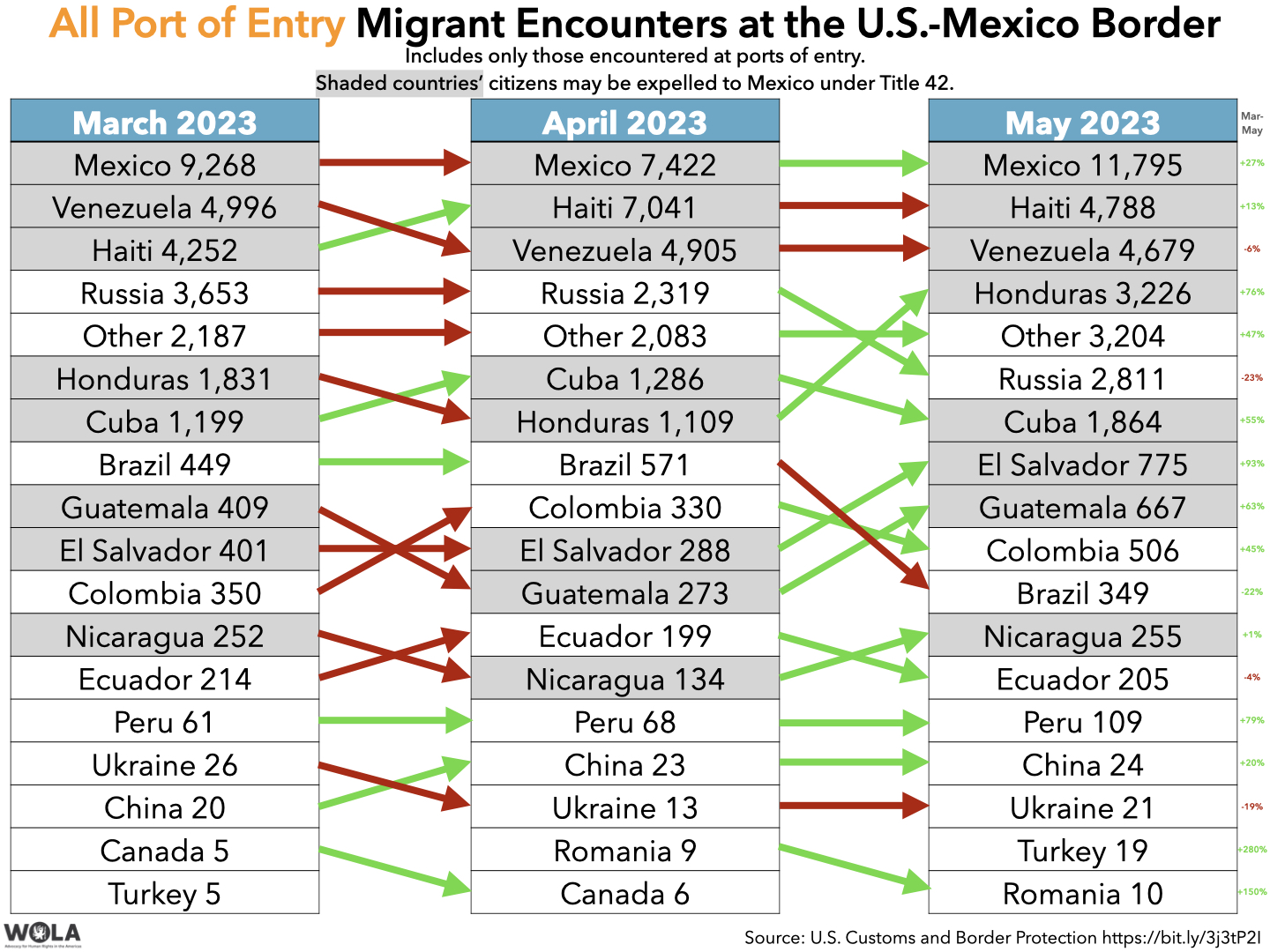
3- The percentage of each country’s migrants who were encountered at ports of entry. This chart shows very wide variation across nationalities, with Russia and Haiti over 90 percent and several countries below 10 percent:
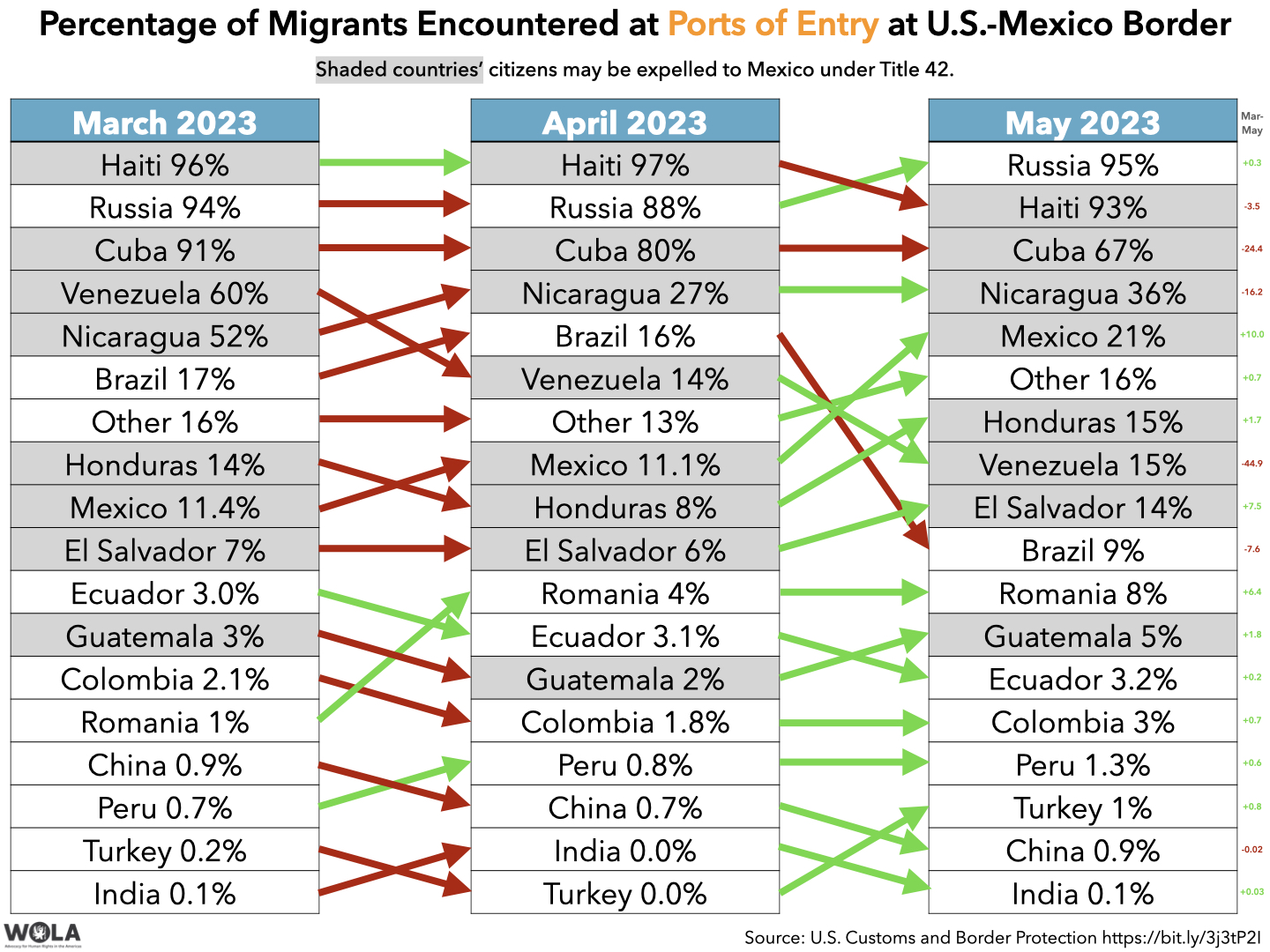
4- CBP’s combined totals, adding together Border Patrol encounters plus port-of-entry encounters:
The full House of Representatives’ Appropriations Committee met for a marathon session June 21 to “mark up” (amend and approve) the 2024 spending bills for DHS and the legislative branch. The House’s Republican majority drafted a bill that reflects deeply conservative priorities. It would block much of the Biden administration’s approach to migration and border security, in the very unlikely event that President Biden signed it into law without the Democratic-majority Senate altering its provisions.
The Appropriations Committee passed the bill on a party-line vote of 33-25. It now goes to the full House. Senate appropriators are working on their own version of the bill but have yet to share a timetable. See WOLA’s March 17 Border Update for an overview of the budget request that the Biden administration had sent to Congress.
Among the House Republican-led bill’s provisions:
At a June 16 funeral service in New York, dozens of people gathered to commemorate Anadith Danay Reyes Alvarez, an 8-year-old girl from Panama, with Honduran parents, who died of influenza on May 17, after nine days in Border Patrol custody in Harlingen, Texas. (See WOLA’s May 26 Border Update.)
“We will let our baby rest and let her rest in peace. We want justice for her so that no one else has to go through this,” read a statement from the family.
Shortly after her death, the girl’s mother, Mabel Álvarez Benedicks, had told the Associated Press that Border Patrol personnel, including medical contractors, had repeatedly denied her appeals for medical aid. The parents had shared documentation about the girl’s existing health issues—a heart condition and sickle-cell anemia—but these were apparently ignored.
In a grim June 1 statement, CBP acknowledged that medical personnel at the Harlingen Border Patrol Station refused to escalate Anadith’s level of care, even as her fever rose to 104.9 degrees early on May 16, the day before she passed. The statement continued:
Contracted medical personnel did not consult with on-call physicians (including an on-call pediatrician) about the girl’s condition, symptoms, or treatment. The contracted medical personnel failed to document numerous medical encounters, emergency antipyretic interventions, and administrations of medicine. A review of CBP records revealed the camera system at Harlingen Station was flagged for repair/replacement on April 13. The outage was not reported to CBP OPR as required by H.R. 1158, Fiscal Year 2020 DHS Consolidated Appropriation.
Anadith Danay Reyes Alvarez was laid to rest in New Jersey on June 17. According to the Associated Press, attorneys with the Texas Civil Rights Project and the Haitian Bridge Alliance have requested an independent autopsy to determine the cause of her death.
On June 15 CBP transferred its chief medical officer, David Tarantino, to another assignment at DHS. (Tarantino’s position was created in 2020, after, as the AP put it, “at least six children died during a roughly yearlong period from 2018 to 2019 during the Trump administration.”) CBP announced that it was “bringing in additional senior leadership to drive action across the agency.” The Washington Post noted that “CBP officials announced a review of all ‘medically fragile’ migrants in custody, and the agency said it has cut in half the amount of time family groups are being held,” while deploying “a team of doctors from the U.S. Public Health Service to provide ‘additional medical guidance and oversight capability.’”
In another Border Patrol-related fatality that took place one day later (May 18), late on June 22 CBP shared body-worn camera footage of the shooting death of 58-year-old Raymond Mattia, a member of the Tohono O’odham nation in southern Arizona. The very strong video shows agents, very much on edge, shooting Mattia multiple times in his front yard.